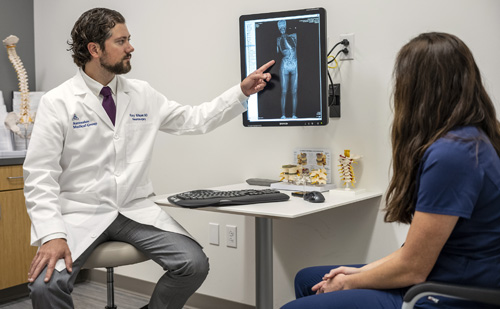Spine Surgery

Overview
Some experts estimate that half of back surgeries are unnecessary. They base that on the fact that the rate of spine surgery in the United States is twice that of other countries. Dartmouth Medical Atlas which looks at clinical outcomes and variability of healthcare found that there is also great differences in the rate of spine surgery in different parts of the United States, with higher rates of spine surgery in those cities where there is an abundance of spine surgeons.
The issue with spine surgery is that spine surgeons can be biased toward treating a herniated disc with surgery. That is why having a multi-disciplinary spine center with physical medicine MDs is essential. Physical Medicine and Rehabilitation physicians can provide non-surgical treatment options like spinal injections that can sometimes relieve the symptoms of a herniated disc.
But when non-surgical treatment options fail to provide relief of symptoms, or when symptoms become serious like numbness or weakness in a hand or foot, surgery must be done promptly to prevent paralysis of these nerves which can cause numbness or weakness to become permanent and lifelong.
In addition to the variability in the rate of spine surgery, there is also great variability in the training of spine surgeons. Some might think having an older spine surgeon may seem to provide longer experience. However, surgeons that were trained in the 1980s were taught to make long 3-inch incisions to access the spine.
Younger spine surgeons coming out of fellowships — the highest level of medical education possible — are taught to operate through a half-inch incision using tubular retractors the width of a ball point pen.
The benefit of this advanced training for the patient is huge. The patient with the half-inch incision goes home the same day and has a quicker recovery with less pain.
Some older spine surgeons stay current and go back to learn the most advanced minimally invasive spine surgery techniques and how to use this advanced instrumentation. Others simply choose to make the large 3-inch incision which is easier for them, but harder on the patient.
Consequently, it is the responsibility of the patient to seek out a spine surgeon who is proficient in minimally invasive spine surgery.
If spine surgery is necessary, the main types of surgery can fall into the following categories:
Discectomy
Discectomy is the removal of the herniated portion of a disc to relieve the pressure on nearby nerves. When the disc herniates, it can press on nearby nerves. This causes leg pain when the herniation is in the low back, and arm pain if the disc is in the neck area. In a discectomy, the surgeon typically only removes the portion of the disc that is causing a problem, not the entire disc. A Cervical Discectomy is a discectomy performed in the neck. A Lumbar Discectomy is a discectomy performed on the low back.
Spinal Fusion
The the disc has badly herniated, the surgeon may need to remove the entire disc to relieve symptoms. Because the disc acts as a shock absorber between two bony vertebrae, something needs to be put back in place of the disc to retain the space between the vertebrae. A surgeon may harvest bone from the patient's hip or obtain it from a bone bank. During a fusion surgery, the surgeon inserts a small wedge of bone in between the two vertebrae to restore the disc space. Over time, the two vertebrae "fuse" together into a solid structure. While this limits movement and flexibility, it can also help to ease pain. The decision to fuse or not to fuse can be a complex one. It will probably be based on the surgeon's assessment of two factors: the amount of instability that a discectomy will cause and how much disc space is necessary to restore the disc space.
Laminectomy
Many spine surgeries in the low back are performed through the abdomen because the disc often herniates forward toward the front of the spine. In some cases, the surgeon may be able to access the herniation through the back which can be a simpler and less complex surgery than through the abdomen around internal organs. But to access the disc from the back, the surgeon has to remove a piece of bone called the lamina, to create a window of access to the disc. A laminectomy involves the removal of part or all of the lamina covering the spinal canal. Removing the lamina is much like removing the cover on a fuse box to access the wiring. By removing the lamina, the surgeon gains access to the disc area and frees more space for the nerves inside. A laminectomy is often used to treat recurrent disc herniations, or where scar tissue is involved. Laminectomy may also be used go relieve pain caused by spinal stenosis where bone encroaches on the spinal canal, much like a ring on a swollen finger.
